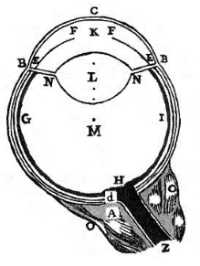The Eye
Table of Contents
If we cut the eye in half without its liquors flowing out, or any of its parts changing place, it would appear below:

ABCB is a hard and thick skin, which composes like a round vase in which all its inner parts are contained.
DEF is another thinner skin, stretched like a tapestry inside the previous one.
ZH is the optic nerve, which is composed of a large number of small filaments whose extremities extend throughout the GHI space, where, mingling with an infinity of small veins and arteries, they compose a species of flesh extremely tender and delicate, which is like a third skin that covers the entire bottom of the second.
K, L, M are 3 kinds of very transparent mucus or humors, which fill all the space contained within these skins, and each has the shape in which you see it represented here.
L is called the crystalline humor. This causes almost the same refraction as glass or crystal.
The other two, K and M, cause a little less, about like common water, so that the rays of light pass more easily through that in the middle than through the other two, and still more easily through these two only by air.
In the first skin, the BCB part is transparent and a little more arched than the rest BAB.
In the second, the interior surface of the EF part, which looks at the fundus of the eye, is completely black and dark.
It has a little round hole FF in the middle, which is called the pupil, and which looks so black in the middle of the eye when you look at it from outside.
This hole is not always of the same size.
The part EF of the skin in which it is, swimming freely in the humor K, which is very liquid, seems to be like a small muscle which can shrink and widen as it goes.
If a child gazes fixedly at a near object, his eyeball will become a little smaller than if you make him gaze at a more distant one, which is not more enlightened.
Even though he is always looking at the same object, he will have it much smaller, being in a very bright room, than if by closing most of the windows we make it very dark.
Finally, that living on the same day and looking at the same object, if he tries to distinguish its smallest parts, his pupil will be smaller than if he only considers it whole and without attention.
This movement is voluntary even if it is ordinarily ignored by those who do it.
because it does not leave for that to be dependent and to follow of the will which they have to see well; as well as the movements of the lips and the tongue which are used to pronounce the words are called voluntary, because they follow the will which one has to speak, notwithstanding that one is often unaware of what they must be to serve for the pronunciation of each letter.
EN, EN, are several small black threads which embrace all around the humor marked L, and which, also arising from the second skin at the place where the third ends.
These seem so many small tendons by means of which this humor L, becoming sometimes more arched, sometimes flatter, according to the intention that one has to look at near or distant objects, changes a little the whole figure of the body of the eye.
When you gaze fixedly at a tower or a mountain a little distant, a book is presented before your eyes, you will not be able to distinctly see any letter in it until their shape is slightly changed.
Finally, OO are 6-7 muscles attached to the eye from the outside, which can move it in all directions.
They can even perhaps, by pressing or withdrawing it, help to change its shape.